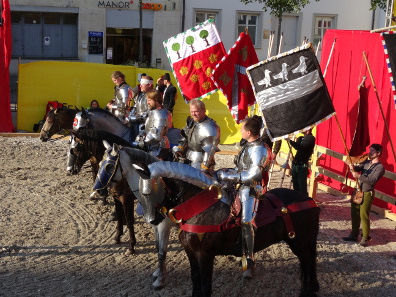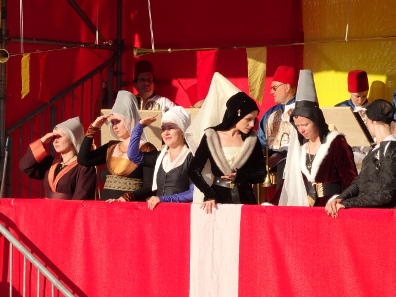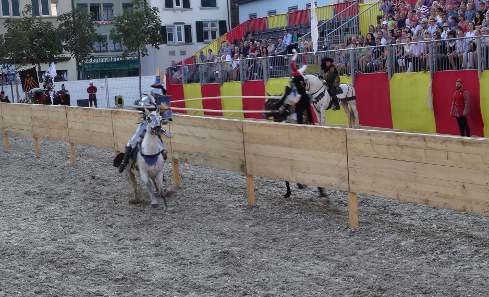by Ursula Kampmann
31 July, 2014 – The Museum zu Allerheiligen at Schaffhausen is currently conducting a highly respected exhibition on knights’ tournaments. And Allerheiligen would not be Allerheiligen if the exhibition was not so much more than a mere collection of inanimate objects put on display to be visited and looked at. The highlight of the program was the reenactment of the original tournament on the actual location from 1436, at the Herrenacker, of which we have detailed information thanks to a report written by a Spanish envoy.
In front of hundreds of guests, the tournament was brought back to life twice a day between 10 and 20 July, 2014. Peter Jezler, the museum’s director, had made sure of the cooperation with the Hofreitschule in Bückeburg and presumably the world’s best jousting riders. Yes, the sports of jousting and tourneying are still being practiced. A small group of keen enthusiasts, which can be counted at the fingers of two hands, had devoted themselves entirely to the training and the reviving of the knightly tournaments – and they are a far cry from such things like stuntmen and Hollywood.
„The tournament was held at Schaffhausen on Shrove Tuesday, in the way described hereafter. Since the previous Saturday, the riders, which amounted to about 210, had arrived.”
The knights, about to compete. Photograph: KW.
There are no more than 210 knights today. Roughly two handfuls of riders still practice the sports of jousting at present. They come from all over the world. Six of them had shown up at Schaffhausen. In order to go easy on human and – most of all – equestrian resources, only four entered the competition. It was an impressive sight all the same to watch the three different kinds of contest.
„At the very day, the ladies arrived; some riding a carriage, of which some are beautifully decorated with paintings, others with silk, although they were not decorated in too lavish a way. With them came a band of minstrels. … Other ladies came on horses, wearing bespangled hats on their head and stuff garments. This was how the majority of ladies entered this day, about hundred in number.”
The ladies are sitting on the stand, watching the events taking place. Photograph: KW.
If Christin Krischke of the Hofreitschule in Bückeburg is approached with the relevant questions, she would instantly explains that, all the knights and the male dominated society notwithstanding, the ladies played a major role in the events. They were by no means mere adornment and decoration, but possessed power over the ‘Lords of the creation’ in case they misbehaved.
„From the tournament yard the ladies, those who felt like it, took themselves to the hall in order to look at the helmets. And every one of these ladies pointed to a helmet of that very knight she had reason to complain about. At the same time, they searched for the helmets of those people that were not allowed to take part in the tournament, and they did find one. … And the ladies sent for the knight marshals, four elder gentlemen, and demanded of them to throw the helmet out of the hall. And so they did; it was thrown onto the street and dragged through the mud. The man they humiliated. … In such cases, the ladies made quite a fuss, because, as they were saying, there were many young ladies with only small assets, and if the sons of noblemen took the citizens’ daughters as wives because of their fortune and enjoyed the very privileges, the noble ladies would get no chance of getting married at all.”
A knight is being put in his place. Photograph: KW.
That, too, could be seen at the tournament at Schaffhausen: a knight who, as the German phrase ‘jemanden in die Schranken weisen’ still reflects in the literal sense of the word, is being put in his place. That involved stripping him of his armor and placing him onto the barrier.
„After the rehearsal, no more than about fifteen combatants arrived at the tournament yard again, ready to begin the tilt; seven of these were thrown in the sand … when their horses turned around. You would have been amazed to see how rarely they attacked in vain, without hitting and without making the lances break and horses or riders fell. … In case one is hit and falls, he is by no means considered a bad rider, only if he screams and wails that he got hurt and raises his arms until he is finally lifted off the ground.”
Jousting as we know it from modern chivalric movies. Photograph: KW.
As a matter of fact, the primary goal was not to unhorse the opponent but, thanks to a well-aimed push, to break the lance upon the impact of the crash. The horses reaching a speed of up to 40 km/h resulted in the momentum amounting to 60 to 80 km/h. The points earned depended on where exactly the opponent was hit, i.e. the shield or the helmet which was a much more difficult spot to reach. Already in the Middle Ages that jouster was disqualified who hit the horse instead of the man. To prevent that from happening, the tilt barrier was introduced in the first place.
The medieval lance was made of spruce wood – and naturally lacked any predetermined breaking point. That was exactly how it was done at the tournament at Allerheiligen. A couple of years ago, lances had been in use made of balsawood – in order to protect the modern riders – but it turned out that serious wounds resulted from this. The wood splintered and the small parts easily penetrated the eye, despite the helmet visor. That was an important insight that would not have gained were it not for the attempt. This is why most of the tournament’s participants see themselves as experimental archaeologists.
„This Monday night, a herald proclaimed that everyone was obliged to be present within the barriers until 11 o’clock the next day, and that the tournament was scheduled for 12 o’clock.”
The herald. Photograph: KW.
Of course, Schaffhausen had a herald, too. To facilitate his work, he used a microphone. It is easy to imagine, though, how sound the voice of his medieval colleagues must have been.
„The following day, it was a Tuesday, all combatants were present within the barriers at the time specified. The two parties were divided at the center of the tournament yard by two ropes, and when everyone had gathered there, the gates of the battle ground were shut, and the knight marshals and the stewards removed the ropes, and the parties began to attack each other. … The contest went on for two hours; although the fight had been announced to take one hour only, it went on for even another half an hour, after the gates within the barriers had already been re-opened, and after the stewards were finally able to put a halt to the fight.”
The mace tournament. Photograph: KW.
While the tilting was more of an advanced skirmish, the “Turnei” or the general mêlée as the true spectacle. As a matter of fact, the tournament derives from the French word ‘tourner’, referring to the twisting and turning of the horses in order to hit the opponent with the mace. Every blow scored, although we have almost no references as to how the fight was conducted exactly. Sources recommend to ‘break through’ once or twice prior to the punishing stage, which we will deal with a little bit later, and that indicates that a kind of cavalry attack was involved.
„After the first attacks were over, everyone mingled, looking for those that were about to be punished. You should be aware of the reasons why these tourneys had been introduced since old times. The noblemen lived constantly in their castles and fortified houses, and if they had not been able to meet at such occasions, they would never have become acquainted with each other and with the laws of knighthood. In addition, the tournaments provided the opportunity that those noblemen could be punished that led a bad and dishonestly life. … The ones of Basel fared worst this time. Amongst these there was the most distinguished man of all that had gathered there, a margrave who resided in this city the bigger part of the year, a shapely man with good manners; he did not live together with his wife; she, on the other hand, gave him thousand gulden she sent him here to enable him to participate in the tournament, and she was present herself. … If the present and the garments she provided him with were not enough already, she even vouched for him, and it was for her sake that he was pardoned although he had already suffered some heavy blows.”
Punishment in the context of a mace tournament. Photograph: KW.
We know of one particular margrave being terribly battered in the tournament of
1436. It was Margrave William of Hachberg-Sausenberg who mingled with the high and the highest society. Philip of Burgundy had appointed him chamberlain in 1434, and in 1437 he became governor of the Duke of Austria’s possessions in the Sundgau, Alsace and Freiburg. So, he was a powerful man that could not be dragged easily to court. His extravagance had already caused him trouble with his relatives. He was married to a rich heiress, Elizabeth, Duchess of Montfort-Bregenz and widow of Duke Eberhard of Nellenburg. To prevent her from being impoverished all of a sudden upon an untimely death of his and become a nuisance to her family, he had to promise not to pledge any income out of his wife’s morning gift. Still, he parted with her in 1436. In the tournament, his peers punished him for that unchivalrous behavior. To batter him, they made good use of their mace with which this part of the tournament was conducted. Hits at the unarmored body were forbidden. Having said that, the matter could become quite hurtful – especially when the lady who had demanded this punishment, did not pardon and put a stop to the beating. Elizabeth of Montfort-Bregenz did show mercy, though. Other ladies did not: Junker (Knight) Hans of Höwen, who had insulted and caused harm to the widow of his late brother, was beaten for such a long time that rumor had it he would probably die of this blows.
The nocturnal tournament. Photograph: KW.
The final part of the tournament which our chronicler from 1436 does not describe anymore is the nocturnal where blunt swords were used to detach the crest of the opponent’s helmet. This was quite hurly-burly, one not everybody joined in medieval times. The dignified men of advanced age in particular withdrew from this kind of burlesque fun.
„When the evening came, everyone went for the hall, and when the dance began, the knight marshal and the judges retired for deliberation on the prizes: the prizes were six rings, four of which to be awarded to the best of the tournament and two for the best of the tilt. When they agreed on who should be given the first, they elected a lady, gave her the rind and told her on the quiet who she should give the ring to. Then, the eldest and most noble gentlemen, each holding torches, walked in front of her, while the lady walked behind, between the knight marshals, old men of excellent nobility, and behind her another twenty ladies followed, two by two. In this fashion they strode through the hall until they reached the victor; and when they caught sight of him, they would never call him nor address him by his name. And when they found him, the lady said to him: he was deemed worthy of this honor because he was considered the most skilled and bravest of all; and she placed the ring on his finger and danced with him, while the noblemen with the torches were present.”
The awarding of prizes. Photograph: KW.
At Schaffhausen, there was no such elaborate thing as a festive award ceremony, no gorgeous celebration with the riders all dressed up after the tournament. Instead, the prizes were awarded immediately after the fight.
Of course, that did not do any harm to the jolly atmosphere of the modern spectators at the Herrenacker. It was splendid to be able to get such an authentic glimpse into the Middle Ages, that sharpens the eye for all the nonsense that is currently touring through the land under this heading.
Anyone who had missed the Schaffhausen tournament but want to learn more about experimental archaeology combined with equestrian sports is recommend to visit the Fürstliche Hofreitschule von Bückeburg where Wolfgang, Christin and Diana Krischke have lined up an interesting program. You can visit a museum and see historic stables with your own eyed, and in addition shows are presented demonstrating baroque riding art in the Renaissance Reithaus.
Apart from that, you might want to check out the exhibition at Schaffhausen which is possible until 21 September.
We reported on the exhibition.
Naturally, it has its own website.
A spectacular video can be watched here.
Plus, one knight was interviewed.













